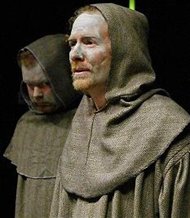Mouth on Fire presents a rare performance of four short works by Beckett, addressing themes of inhumanity, imprisonment, power and torture. Against the asperous stone walls of Smock Alley’s Boys School, the make-shift wooden stage straddling the balcony arches provides the perfect unadorned focal point for the programme’s central action within this lofty space.
The ensemble opens with a reprieve of one of Beckett’s last short plays, Catastrophe (1982), performed earlier this year as part of the company’s Silence and Darkness production. Cathal Quinn reassumes his befitting role as Director in the rehearsal of the final scene of a ‘catastrophe,’ instructing his assistant (Melissa Nolan) with virulent audacity in the meticulous modifications he deems necessary to be made to the hopelessly resigned Protagonist (Colm O’Brien).
The stereo-effect of the performers' voices - Assistant from the ground and pedestal, Director from the chair and stalls, and Luke (John Cullen) from the darkened heights - works particularly well in the tiered space, and the piece reaches its catastrophic triumph in the closing cadenza when Becky Gardiner’s bluish burrow of light solely illuminates the Protagonist’s head as he raises it in a stunning act of resistance against the Director’s final aesthetic vision. The ‘long pause’ is then fully executed, allowing the acute sense of degradation seen in the twisted physiognomy of O’Brien’s expression to be regarded.
While Nolan employs an appropriately nimble nervousness in her verbal compliance, her responses to Quinn are delivered with such haste that a word is lost here and there. The bloody slashes to O’Brien’s chest and shin are an interpretational addition to the tableau of the silenced spectacle, serving merely to overstate a sense of torture and tyranny that is already inherent in this piece.
 Following this, Nick Devlin undertakes a staged rendition of Beckett’s short prose piece As the Story was Told (1973), originally dedicated to the poet and dramatist Günter Eich who was imprisoned in 1945. Bathed in an emerald light, Devlin articulates the text from a static off-centre position with a fine sense of pace and cadence, relaying, with minimal detail, a story told about “sessions” of a “harrowing nature.” The achievement of the performance lies in Devlin’s ability to maintain his twice-removed distance from the story itself, demonstrated in his careful delivery of the opening line: “As the story was told me I never went near the place during sessions.” The effect is that Devlin, as narrator, essentially disappears from our experience of the narrative altogether, leaving us not with the story, but, faithful to Beckett’s objectives, the story purely as it was told.
Following this, Nick Devlin undertakes a staged rendition of Beckett’s short prose piece As the Story was Told (1973), originally dedicated to the poet and dramatist Günter Eich who was imprisoned in 1945. Bathed in an emerald light, Devlin articulates the text from a static off-centre position with a fine sense of pace and cadence, relaying, with minimal detail, a story told about “sessions” of a “harrowing nature.” The achievement of the performance lies in Devlin’s ability to maintain his twice-removed distance from the story itself, demonstrated in his careful delivery of the opening line: “As the story was told me I never went near the place during sessions.” The effect is that Devlin, as narrator, essentially disappears from our experience of the narrative altogether, leaving us not with the story, but, faithful to Beckett’s objectives, the story purely as it was told.
In contrast to the manipulations of light exercised in the first two pieces, we are enveloped in total darkness for Rough for Radio II (1961), but for a few faint splashes of red light projected high above our heads. These are hauntingly synchronized with the swishes and thuds of Dick’s (a mute character) bull’s pizzle-whip hitting the flesh of the victim, Fox (O’Brien), in an attempt to make him speak. The voices, sounds and squeals rise and boom, as they should, out of hellish darkness, masking the image of yet more torture, leaving us only to imagine. Even in the realms of such a disturbing sound-scape, however, Beckett’s dark humour is underscored in the exchanges between the Animator and Stenographer, handled with pitch-perfect dynamicism by Quinn and Nolan respectively.
In the last piece, What Where (1983), which is also Beckett’s last play, excellent use is made of the balcony space with its four gowned characters appearing and reappearing out of the darkness within the arches. The brilliantly abrasive voice of Bam (Devlin, who also plays Bam in the flesh) is represented by a partially concealed gramophone hung in the downstage left corner and illuminated by a pulsating bulb set into its bell. Each of the characters - Bam, Bom, Bim and Bem - first appear and halt silently in rotation in a kind of rehearsal (recalling the opening Catastrophe) before the voice of Bam approves, declaring “Good. I switch off. I start again.” This other-worldly authorization gives way to the interrogations Bam inflicts on each of the characters in turn, who disappear, as instructed, to torture an unseen “him” to say “it” until he “wept,” “screamed,” “begged for mercy,” and finally “passed out” without saying anything. Bam then accuses each of the characters of lying to him, threatening them with the same “works” inflicted on the unnamed until they confess that the latter said “it” to them. In the end there is no one left to torture or to accuse, and the light switches off.
Altogether, this quartet of Beckett shorts makes what is difficult seem easy with a fluent and passionate ensemble of performers who are devoted to making the works of Beckett accessible to all, an aim that can only be admired and encouraged.
Jennifer Lee holds an MPhil in Theatre and Performance and is currently completing her PhD thesis.